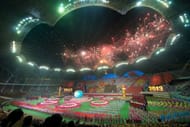For any sport, the arena or the battlefield matters a lot. It is like a special piece of ground, where history keeps getting created again and again. For players, these arenas hold special importance and they evoke memories which cannot be expressed in mere words. Just ask any top tennis player about the importance of Wimbledon Centre Court in their memories. Or ask any cricketer about Lords.
There are many such huge battlegrounds in the sports world. However the biggest of them all is the Rungrado 1st of May Stadium, a multi-purpose stadium in Pyongyang, North Korea. It has a seating capacity of 150,000 and occupies an area of 20.7 hectares. It is simply huge!
Let us have a detailed look at the history of this stadium, and what makes it so special.
A look into the design of the Rungrado 1st of May Stadium
The name of this stadium comes from Rungrado Islet in the Taedong River, upon which it is located, and May Day, the international labour day. Its crenated roof has 16 arches which are arranged in the shape of a ring, and it resembles a magnolia blossom.
The stadium has around 1,50,000 seats and a total floor area of more than 2,07,000 square metres. It has eight storeys in all and stands at an impressive height of more than 60 metres from the ground. The 60-metre long canopy is enough to cover the section of the stands.
#Rungrado 1st of May Stadium is largest in the world by capacity, seating 150K #Pyongyang #NorthKorea https://t.co/zm5YL4zdBN
— Will Ripley (@willripleyCNN) July 1, 2015
The pent of the inner roof is 60 metres long and the outer roof 40m long. The 16-arch roofs link with one another and resemble flower petals when looked from above.
The roofs give an impression of a large flower floating on the waters of the Taedong, or a parachute which has just landed, thereby making it a dynamic structure. The stadium has 80 exits and ten lifts.
The stadium has many training halls, recreation rooms, an indoor swimming pool, an ultrasonic bath, a sauna, beds and many other modern facilities, which help the players in their training needs and make them feel comfortable. It also has many dining rooms, a broadcasting room and telex booths. The indoor running track runs into hundreds of metres and is located on the sixth floor.
Big sporting events this stadium has witnessed

The stadium hosts football matches and athletics events but is also readily used for the world famous Mass Games held to celebrate former leader Kim II-sung and the North Korean nation.
In June–July 2002, it was the site of the stupendous and meticulously planned "Arirang" gymnastic and artistic performances. These games are often referred to as "mass games". The extravaganza saw more than one lakh participants perform, which was double the number of spectators.
These performances have now become an annual event in Pyongyang, and are usually organized in the months of August and September. The Guinness Book of Records recognises these events as the largest in the world.
The stadium was also witness to “Collision in Korea”, the largest professional wrestling pay-per-view event ever. It was jointly produced by World Championship Wrestling and New Japan Pro Wrestling, tow of the biggest professional leagues in the world. The event was organized on April 28 and 29, 1995 and saw a record attendance of 150,000 and 190,000 on the two days.
The stadium is also currently the largest football stadium on the planet. It has seen many of the football matches of the North Korean national team. Let us have a look at this video of a World Cup qualifying match between North Korea and Iran in 2009, at this stadium. The atmosphere in this huge cauldron is something to behold.
